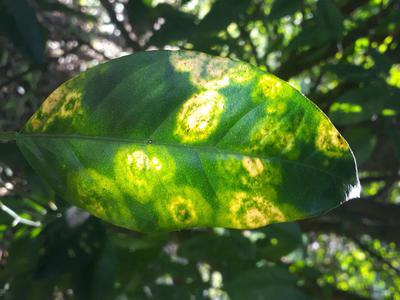Citrus Leprosis
Citrus leprosis virus sensu lato
Virus
In a Nutshell
- Circular lesions with central mite feeding spot on leaves.
- Small, chlorotic lesions on stems.
- Numerous, dark depressed lesions on fruit.
Can also be found in
Symptoms
The virus produces localized symptoms in leaves, stems, and fruits. In leaves, characteristic lesions are often large and circular (from 5 to 12 mm in diameter), light yellow to dark brown and with a central necrotic spot ranging 2-3 mm in diameters. This feeding spot is surrounded by a chlorotic halo that may develop forming 1-3 concentric rings that may coalesce. In older lesions, a darker central point can also be observed. In young stems, lesions are small, chlorotic and shallow. With time, they extend along the stem and coalesce, becoming dry, darker brown or reddish. Cuttings along the growth axis show that the lesions extend to the inside of the branch. In fruits, dark and depressed lesions are found in large numbers and affecting only the external part. Fruits may fall or simply become unmarketable.
Recommendations

Organic Control
Predators of the vector mites are frequently found in the same environments as the Brevipalpus species. Mites of the Phytoseidae family such as species of the genus Euseius, Amblyseiu, Phytoseiulus or Iphiseiodes zuluagai are the most important natural enemies of the mite vector B. phoenicis in citrus groves. Formulations containing the entomopathogenic fungi of the genus Metarhizium or Hirsutella thompsonii can also be used to reduce populations.

Chemical Control
Always consider an integrated approach with preventive measures together with biological treatments if available. Formulations of miticites containing the active ingredient acrinatrin, azocyclotin, bifentrin, cyhexatin, hexythiazox, fenbutatin oxide are recommended against the mites that carry the citrus leprosis virus.
What caused it?
The symptoms are actually caused by a group of three viruses, which cause similar symptoms in the citrus hosts. These viruses are transmitted with more of less efficiency by several mites of the genus Brevipalpus. For example, from the three mites known to transmit the disease in California, B. californicus, B. obovatus, and B. phoenicis, the latter is considered to be the main vector. Beside citrus, they also have a broad host range and are widely distributed. All active stages of the mite (larvae, nymph, and adult) can acquire and transmit the virus, although it has been reported that larvae transmit the virus more efficiently.
Preventive Measures
- Obtain seeds and budwood from certified sources.
- Remove affected trees or prune diseased branches.
- Control weeds in and around the orchards.
- Build windbreaks to prevent mites from spreading.
- Maintain a high level of hygiene between workers and tools.
- Control transportation of infested citrus tree material.



